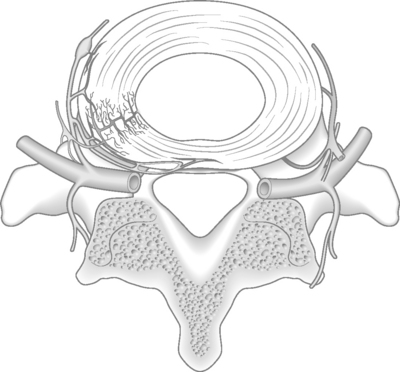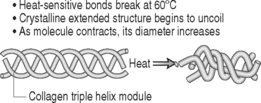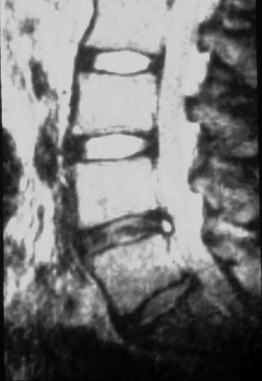CHAPTER 96 Intradiscal Electrothermal Annuloplasty
INTRODUCTION
Spine specialists have been frustrated by the lack of effective treatments for chronic low back pain. The intervertebral disc is believed to be the source of low back pain in as many as 40% of patients with chronic low back pain.1–4 The results from conservative therapies are frequently poor in this patient population. Over the years, a number of intradiscal techniques to either shrink or remove disc material believed to be causing lumbar pain and/or radiculopathy have been described.5 These techniques include interbody fusion, posterolateral fusion, microdiscectomy, arthroscopic discectomy, automated percutaneous lumbar discectomy, chymopapain, as well as other procedures.6–10 Recently, a new technique has been developed that involves the percutaneous insertion of a thermal resistance probe with controlled heating of the disc material.11–14 This technique is known as intradiscal electrothermal annuloplasty (or IDET).
Intradiscal electrothermal annuloplasty was developed as a minimally invasive procedure for the treatment of pain due to degenerative disc disease.15 The procedure has been used in the lumbar spine of patients who have failed conservative treatment regimens and who might otherwise be candidates for a spinal fusion procedure. The IDET procedure was developed by two brothers, Drs. Jeffrey and Joel Saal, specialists in physical medicine and rehabilitation. The procedure was developed to offer patients with chronic discogenic low back pain an option other than chronic pain management for spinal fusion.16 The IDET procedure is specifically devised to treat degenerative disc disease resulting in chronic low back pain. Thermal energy had been shown to induce tissue shrinkage in cadaveric and animal models.17–20 Saal and Saal hypothesized that thermal energy might have a role in the treatment of so-called ‘internal disc disruption,’ and, thus, in chronic low back pain.13 This proposition led to the development of a catheter to deliver intradiscal electrothermal annuloplasty therapy.17
PATHOPHYSIOLOGY OF DISC DEGENERATION AS IT RELATES TO IDET
The pathophysiology and origins of low back pain of discogenic origin are incompletely understood.21 One theory hypothesizes that small, post-traumatic peripheral tears of the anulus fibrosus lead to an acceleration in the dehydration of the intervertebral disc, with resultant fraying of the nucleus pulposus.17,22 Studies using annular trauma in a sheep model support this theory.23 The intervertebral disc is surrounded by an external continuous plexus of interlacing nerve fibers. Contributions to this network occur ventrally from a plexus surrounding the anterior longitudinal ligament and dorsally from a plexus surrounding the posterior longitudinal ligament.21 Vascular ingrowth also has been observed in peripheral tears of the anulus. Nociceptors may accompany this vascular growth and account for the presence of sensory nerve supply in the inner anulus (Fig. 96.1).
In the normal intervertebral disc, sensory nerves do not penetrate beyond the outer one-third of the anulus fibrosus.1 In degenerative disc disease, however, an association has been demonstrated between the ingrowth of nerves expressing substance P and disc degeneration. Disc degeneration and disc injury are associated with centripetal growth of nerve fibers in the disc, which would provide a morphologic basis for true discogenic pain. It is this ingrowth of nerve fibers that is believed to be the source of back pain of discogenic origin.
INTRADISCAL ELECTROTHERMAL THERAPY
The theoretic basis for IDET is that targeted thermal energy within the pathologic disc is designed to shrink collagen fibrils, cauterize granulation tissue, and coagulate nerve tissue in the posterior anulus fibrosus.13,16 When temperatures above 65°C were applied to cadaveric shoulder capsules, studies have shown shrinkage of the specimen and, histologically, hyalinization of the collagen (Fig. 96.2).18 The procedure is supported by basic science research performed by investigators who assess in vitro temperature mapping and demonstrated that thermal resistance catheter heating conducted temperatures sufficient to coagulate nerve endings and to contract collagen.24 Bono et al.25 documented in a cadaver model the temperature sufficient for collagen denaturation and nociceptive ablation were detected at distances greater than previously documented. These data suggest that the proposed heat-dependent mechanism of action in intradiscal electrothermal therapies are achieved in most discs. Among other factors, intraspecimen variability of maximum temperatures may help explain the somewhat inconsistent clinical results following intradiscal electrothermal therapy. One in vitro study, however, suggested that the temperatures developed during intradiscal electrothermal therapy were insufficient to alter collagen architecture or stiffen the treated motion segment acutely.26 Kleinstueck et al.26 also investigated the biomechanical effects of IDET on vertebral motion. It is plausible that the heated catheter denatures and shrinks the collagen fibrils, thus stabilizing the motion segment. In this cadaveric study, there was an increase in motion at the IDET-treated levels. This investigation, however, did not take into account the effects of subsequent scarring that would occur over time in vivo. Subsequent scarring may result in stiffening and stabilization of the motion segment over a period of time consistent with the clinical relief of pain at 1–3 months. Other studies27 have shown a similar triad of biologic repair in the therapeutic effect (maintenance of shrinkage, secondary scarring and thickening, and destruction of sensory fibers). Gross pathology before and after treatment demonstrates shrinkage of the nuclear matrix.17 Although the in vivo response has not yet been proven, IDET is likely successful in denervation of the anulus fibrosus through temperature modulation.28
INDICATIONS FOR INTRADISCAL ELECTROTHERMAL
The indications for IDET are generally felt to be similar to those for interbody fusion, and apply the same diagnostic and treatment criteria. As with most treatments, patient selection may be the single most important criterion for a successful outcome. Discogenic low back pain is the most common condition treated with IDET, and its presence is the primary selection criterion. Patients should have chronic low back pain in the absence of other readily identifiable structural abnormalities. Discogenic pain is most often defined as unremitting, persistent low back pain that is worse with axial loading and improved with recumbency. The low back pain is greater than leg pain. This is a nociceptive pain and not a neuropathic pain syndrome.29
Patient selection criteria for the IDET procedure are similar to those used for spinal fusion for degenerative disc disease of the lumbar spine (Table 96.1).15 Several authors have published strict inclusion criteria as well as exclusion criteria (Table 96.2).13, 30, 31 The primary indication is unremitting, persistent low back pain. An additional criterion is a failure of satisfactory improvement with a nonoperative care program that includes back education, activity modification, a progressive and intensive exercise program, a trial of physical therapy, and use of oral nonsteroidal antiinflammatory drugs. These authors have described the failure of the conservative (nonoperative) treatment as a minimum 6-month period of comprehensively applied nonoperative treatment with the patient reporting persistent pain and disability, dissatisfaction with quality of life, and a desire to pursue alternative treatment options. Physical examination should include a normal neurological examination with a negative straight leg raising sign.
| Intrusive low back pain for more than 3 months |
| Failure to achieve adequate improvement with comprehensive nonoperative treatment |
| No medical or other systemic causes for the low back pain |
Table 96.2 Contraindications for APLD
| INCLUSION CRITERIA | |
| Duration of symptoms of at least 3–6 months | |
| Failed 6 weeks conservative care | |
| Abnormal disc morphology | |
| Predominance of low back pain symptoms | |
| Concordant pain reproduced on discography | |
| EXCLUSION CRITERIA | |
| Abnormal neurological findings/compressive lesion | |
| Severe disc degeneration | |
| Segmental instability | |
| Other medical conditions | |
| Consideration of previous surgery | |
Imaging studies are necessary in the diagnostic evaluation process. Magnetic resonance imaging (MRI) confirms the presence of disc degeneration, desiccation, high-intensity zones (Modic endplate changes), and loss of disc height (Fig. 96.3). Contained disc fragment herniations may also be present. Extruded and free fragments of disc cannot be effectively treated using this procedure, but patients with these lesions may be treated for discogenic low back pain with the proviso that the fragments will be unchanged after treatment. We do not feel that a focal protrusion of a disc is a contraindication to performing the IDET procedure. The authors have not seen a single clinical case in which a disc herniation occurred after the IDET procedure. There does not appear to be any increased risk if undertaken in such discs.
Karasek and Bogduk11,30 state that the major indication for IDET is internal disc disruption, not merely discogenic pain. This internal disc disruption may be diagnosed by a combination of disc stimulation (‘provocative discography’) that produces concordant pain with no pain replication at adjacent levels, and a computed tomography (CT) scan after discography that reveals an annular tear. Both criteria must be met in order for the discogram to be considered ‘positive.’ The author often employs provocative discography, conducted by an unbiased interventional spine physician.13 This diagnostic study is used to confirm the clinical suspicions, and its results may be used as exclusionary criteria for patients with multilevel disease. Postdiscography CT also provides technical information regarding placement of the intradiscal catheter by evaluating the location and degree of annular disruption (Fig. 96.4










